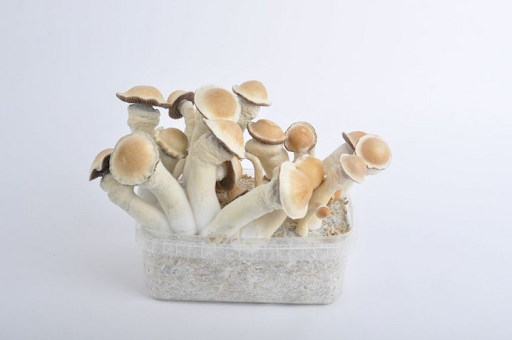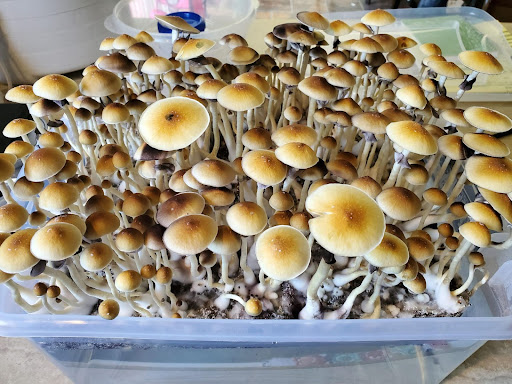Magic Mushrooms and their effect
Magic mushrooms are a type of mushroom that contains psychoactive compounds known as psilocybin and psilocin. These compounds produce a range of physical and psychological effects, including altered states of consciousness, changes in perception, emotions, and thoughts.
Some of the most common effects are clearer vision and hearing, a feeling of being more aware, euphoria, and a sense of being connected to the universe. They can also cause nausea, drowsiness, and a temporary increase in heart rate and blood pressure. Since the Middle Ages, people have used magic mushrooms for spiritual and medical purposes, as well as for fun.
Magic mushrooms are often consumed for their psychedelic effects, which can range from mild alterations in perception to more intense experiences.
Some people may experience intense spiritual or mystical experiences as well. In addition, magic mushrooms can cause nausea, diarrhea, an increased heart rate and blood pressure, and a feeling of disconnectedness from reality.
Here are the three types of magic mushrooms that you really must try.
- Albino penis envy
- Blue Meanies
- Enigma mushrooms
The famous Albino Penis Envy

These mushrooms are a very strong strain of the magic mushroom, Psilocybe cubensis. These mushrooms are a reliable source of the hallucinogenic chemical psilocybin and have high quantities of it. People say that when they eat these mushrooms, they have intense psychedelic visual and emotional experiences.
Magic mushrooms may have a variety of effects depending on the user and dosage, but they often result in feelings of happiness, wellbeing, and heightened creativity. Additionally, some claim to have heard or seen hallucinations.
Psilocybin, a chemical found in hallucinogenic mushrooms, interacts with 5-HT2A serotonin receptors on the surface of nerve cells. The “feel-good” molecule serotonin has a role in mood, cognition, perception, and sleep regulation.
Penis envy Mushrooms are a kind of psychoactive fungus. They contain psilocybin, the primary component that causes hallucinogenic “trips.” This might result in short-term adverse effects, including anxiety and paranoia.
As a result, the way information travels between various brain areas is altered when psilocybin binds to serotonin receptors. As a consequence, awareness and perception are altered. Whether these changes are good or bad for a person depends on how they feel, what they expect, and their situation.
What are Blue Meanies
The genus Panaeolus contains Panaeolus cyanescens. This widely distributed genus produces mushrooms that are typically tiny, contain black spores, and often grow on dung. But not all Panaeolus contain psilocybin—a point we’ll return to in a later section of this essay. Thirteen species of the Panaeolus genus, including Panaeolus cyanescens and Panaeolus cinctulus, are known to generate psilocybin. The uneven flecks or patches of color on the gills of Panaeolus mushrooms give them the nickname “mottlegills.”
Panaeolus cyanescens often matures in the wild as a light gray or off-white. The caps are light brown when young, fading to off-white or light gray as they age. They can have brownish or yellowish tones. The caps (pileus), which start out with a hemispherical shape and then grow into a bell shape or a convex shape, have a diameter of 0.5 to 2 cm. When young, the cap margin is incurred. The caps are somewhat hygrophanous and lose color as they dry out. In dry conditions, they often shatter.
Where do Blue Meanies Mushrooms Grow?

Panaeolus cyanescens is a species native to the tropics and subtropics. In tropical locations, mushrooms grow throughout the year. Depending on rainfall and humidity, they grow from late spring to autumn in the subtropics. They are known to inhabit temperate regions during rainy and humid summer months. Blue Meanies are often seen growing individually or in small groups on cow or horse manure in pastures and fields. They emerge in the spring or during wet seasons.
Blue Meanies mushrooms can be grown, however, they are notoriously more difficult to produce than Psilocybe cubensis. In a proper environment, it is simple to cultivate them outdoors. With the correct setup, they can be grown inside, but it takes patience and plenty of care and attention. Before making Blue Meanies, you should try to do well with cubensis, since they are seen as a more difficult and intermediate task.
Exclusive Enigma Mushrooms
Enigma Cubensis is a mutant variant of the renowned hallucinogenic mushroom Psilocybe cubensis. This mutation is known as the “blob mutation,” and it essentially prevents the production of spores in Enigma mushrooms. Rather, Enigma mushrooms must be spread by cloning. Even in the far future of 2022, this is still thought to be somewhat odd.
When compared to common Psilocybe cubensis mushrooms, Enigma mushrooms have somewhat different trip effects and strengths.
Hallucinations, changed emotions, altered vision, and altered cognitive processes are all side effects of enigma mushroom consumption. Enigma mushrooms’ effects are dose-dependent; thus, with smaller dosages, mood and mental shifts may occur without hallucinations. While taking more Enigma mushrooms, you may experience some fairly bizarre hallucinations and changed perceptions of reality.
Enigma mushrooms may influence emotions in a variety of ways, including feelings of exhilaration and closeness as well as the worry that might accompany a terrible trip, which can happen on any mushroom trip. Additionally, physical side effects including poor coordination, nausea, and vomiting are possible with enigma mushrooms.
What do Enigma Mushrooms look like?

Enigma mushrooms are renowned for both their peculiar development and their peculiar appearance. Compared to other mushrooms, they have a rather peculiar appearance.
Enigma mushrooms contain blobs, as opposed to other, more typical Psilocybe cubensis specimens that have mushroom caps.
These blobs develop into thick, coral-like blobs that resemble brains, cauliflower, broccoli, or a coral reef. They are often blue in hue and thick, with sluggish growth.
Enigma mushrooms are different from most mushrooms because they don’t have caps from which spores can spread. Spores are how most mushrooms reproduce. Instead, the only way to spread Enigma is by cloning.